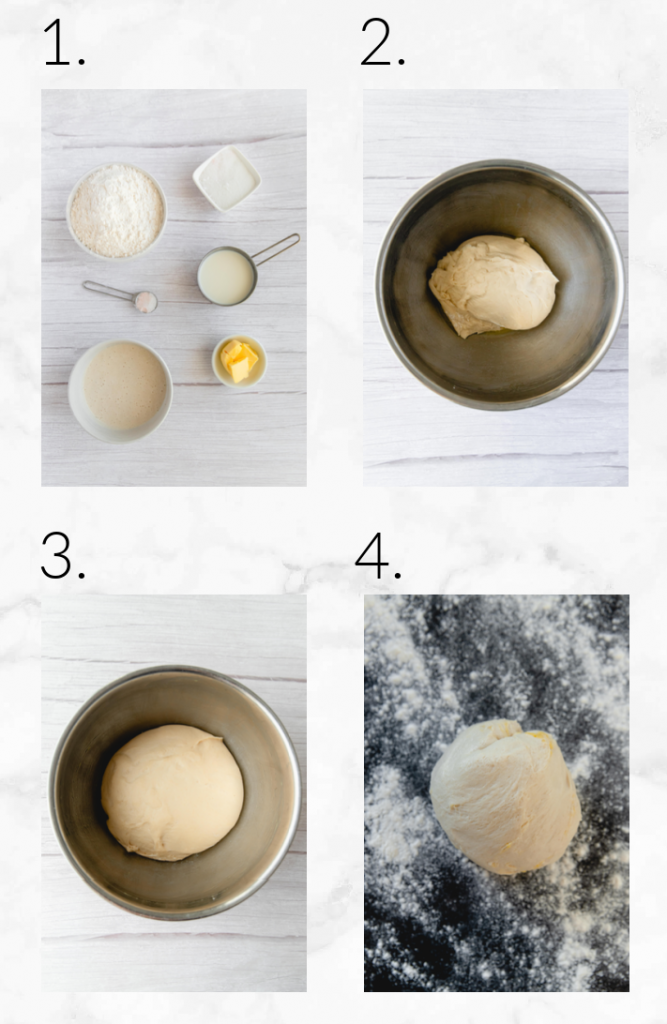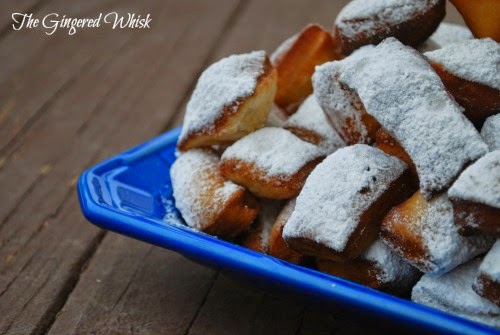Sourdough Beignets
Sourdough Beignets are pillows of fried dough that have a slight sourdough tang that works perfect here, and the texture is awesome. Pillowy and soft, with a slight chew. A great recipe to make with your sourdough starter!


When you think of New Orleans, beignets are the ultimate dessert.
A good beignet is golden and crisp on the outside, with an interior that has air pockets that make them pillowy and soft and dusted with powdered sugar. A great beignet will remind you of a donut or a fritter
By adding sourdough starter to your beignets, not only do you get a really great texture and structure to the dough – which gives it more bite and chew – but the sourdough also deepens the flavor and makes it utterly amazing.
For a whole New Orleans style treat, make a complete meal with Chicken and Sausage Gumbo, Choux Maque Corn, and these beignets!

I love this recipe because its relatively quick and easy (as far as sourdough recipes go, anyway!) The dough is rather forgiving, and
It’s one of my favorite beginner sourdough recipes because you can practice the timing of your sourdough starter being active, as well as your proofing and bulk ferment, without having to worry too much about your gluten development.
Other beginner sourdough recipes that help with these steps are sourdough english muffins, sourdough naan, and sourdough cornbread.
New to sourdough? Read my ultimate guide to sourdough for beginners to get all the answers to your questions in easy to understand ways!

How to make sourdough beignets
For the full set of directions, please make sure you scroll down to the recipe card below. Here is an overview of how to make this recipe:
How to make the beignet dough
- In the bowl of an electric mixer, combine the sourdough starter, flour, granulated sugar, buttermilk, melted butter, and salt.
- Knead on low speed for 5 minutes, until all the ingredients are combined and the dough forms a ball that is slightly sticky.
- Place the dough in a lightly greased bowl, cover with plastic wrap and allow to sit on the counter in a warm spot for 4 to 6 hours. It should be almost doubled in size.
- Place the bowl in the fridge, and allow to ferment overnight, or up to 48 hours.

How to fry the beignets
- Heat a large skillet with about 2″ of canola oil in it until hot (about 325 degrees)
- Lightly flour the counter.
- Roll the dough out into a large rectangle about ¼” thick.
- Cut the dough into squares about 3”.
- Working with 4-6 squares at a time (don’t crowd your skillet!) drop the dough into the hot oil, flipping them often until they are golden brown and puffed. This will literally take a few seconds, so don’t walk away!
- Transfer to a cooling rack set over a baking sheet for a few seconds and then dust with powdered sugar.
- Repeat and enjoy!
These beignets are best when served super fresh, so enjoy them right away!

Baker’s Schedule
The best way to figure out your timing to make this recipe is to work backwards timewise. In total, this recipe takes about 14 to 15 hours. You need a starter that is active, so you need to build in time for that, too.
- Feed your starter – 4 to 6 hours, depending on the temperature and humidity of your house
- Mix the dough – about 10 minutes
- Bulk Ferment – 4 to 6 hours in a warm spot, or until doubled in size. The dough should be slightly rounded at the tops and edges, bubbly on the surface, and jungle slightly when shaken. If you poke the dough, the indentation should spring back slowly to its original shape. (This helps the final stages of gluten development).
- Cold Retardation – At least 8 hours, or up to 48 hours. This helps to develop the sourdough flavor, and slows the rise time, and allows you to time the recipe better.
- Rolling, cutting, and frying the dough – 30 minutes or so, depending on how fast you work.
- Feed your starter – 4 to 6 hours, depending on the temperature and humidity of your house
- Mix the dough – about 10 minutes
- Bulk Ferment – 4 to 6 hours in a warm spot, or until doubled in size. The dough should be slightly rounded at the tops and edges, bubbly on the surface, and jungle slightly when shaken. If you poke the dough, the indentation should spring back slowly to its original shape. (This helps the final stages of gluten development).
- Cold Retardation – At least 8 hours, or up to 48 hours. This helps to develop the sourdough flavor, and slows the rise time, and allows you to time the recipe better.
- Rolling, cutting, and frying the dough – 30 minutes or so, depending on how fast you work.

Tips for how to fry beignets
What kind of pan should you use to fry in?
You want a cooking vessel that is heavy, and stable and both wide and deep. A deep cast iron skillet is the best option. You can also use a dutch oven.
What kind of oil should you use for frying?
The oil you use for frying should be clear, relatively flavorless, and should be able to be heated to high temperatures without smoking. When a hot oil starts smoking, it starts breaking down, and you don’t want that while you are cooking with it. Good choices are peanut oil, safflower oil, sunflower oil, and canola oil. Olive oil is not a good choice for frying as it starts smoking at lower temperatures.
How much oil do I need to fry beignets?
The amount of oil you use for frying depends on what kind of frying you want to do. For this recipe, we need about 2″ of oil in the bottom of your pan.
How hot do I need to heat the oil to?
Place the oil in the cold pan and turn it on to medium-high heat. Getting the oil hot and keeping it at that temperature is important for correctly fried foods that are moist and tender inside and golden and crispy outside.
Oil that is too hot will burn the outside while not cooking the inside. Oil that is not hot enough will cause the beignets to cook too slowly, and it will absorb too much oil, which makes them taste not as good and also have a greasy mouth feel.
You want to heat the oil to 365°–375°F. Use a deep fat frying thermometer to monitor the temperature while you cook.

What kind of sourdough do I need for this recipe?
This recipe uses a sourdough starter that is at a 100% hydration. Your starter needs to have been fed and is active – meaning it has doubled and bubbly. For reference on how to properly feed your sourdough starter and how to know when it is active, read the article Feeding Your Sourdough Starter.
The starter should be at room temperature when you use it for this recipe, as that helps it to mix into the batter better.
Food tastes better when its shared! If you try this recipe, let me know! Leave a comment and rate below! Love and links are always appreciated! If you’d like to share this post, please link to this post directly for the recipe, please do not copy and paste or screenshot. Thanks so much for supporting me! xoxo

Sourdough Beignets
Equipment
Ingredients
- 1 cup 100% hydration Sourdough Starter fed and active
- 3 cups unbleached all purpose flour
- ¼ cup granulated sugar
- 1 tsp kosher salt do not use iodized salt
- 2 TBSP melted butter
- ¾ cup buttermilk
- canola oil for frying
- powdered sugar for dusting
Instructions
- In the bowl of an electric mixer, combine the sourdough starter, flour, granulated sugar, buttermilk, melted butter, and salt.
- Knead on low speed for 5 minutes, until all the ingredients are combined and the dough forms a ball that is slightly sticky.
- Place the dough in a lightly greased bowl, cover with plastic wrap and allow to sit on the counter in a warm spot for 4 to 6 hours. It should be almost doubled in size.
- Place the bowl in the fridge, and allow to ferment overnight, or up to 48 hours.
- Heat a large skillet with about 2" of canola oil in it until hot (about 325 degrees)
- Lightly flour the counter.
- Roll the dough out into a large rectangle about ¼" thick.
- Cut the dough into squares about 3”.
- Working with 4-6 squares at a time (don’t crowd your skillet!) drop the dough into the hot oil, flipping them often until they are golden brown and puffed. This will literally take a few seconds, so don’t walk away!
- Transfer to a cooling rack set over a baking sheet for a few seconds and then dust with powdered sugar.
- Repeat with remaining dough.
- Enjoy while they are still warm!!!
Notes
Nutrition







They look delicious! You can tell how light and crisp they are from the photo. Okay, right, I'm going to have to give them another go at some point over the next week or two.
Very nice! I really liked the sourdough flavor in these too.
Wonderful post. I hope you find a way to get rid of the raccoons at your house. Thanks for working so hard on Sourdough Surprises.
Such beautiful pillows!
Warm beignets are the best! We had some left over, they warmed up well in the toaster. Yum.
I just mixed these up and ready to pop in the refrigerator. Would you be able to convert your recipes by weight? Since I have been baking breads, I love baking by weight. Thanks for sharing a yummy recipe!
Would these work with yogurt or regular milk instead of the buttermilk?
I have always used yogurt. It has the same ph as buttermilk. Worked fine for me.
What a great recipe! I love the tart sour flavor and lovely dough! I drizzled mine with honey, which complemented them nicely. I will be making these again!
Hi! Thank you for this recipe! I wonder, could you freeze the dough?
I have not tried freezing the dough for this recipe. If you try it, let me know how it goes!
Could they be fried in coconut oil?
It depends! You will want to make sure you use refined coconut oil to fry in. Unrefined or virgin coconut oil has a smoke point of 350 F, and you will need the oil to be about 325 F to properly fry the beignets, which could easily get too hot and start smoking. So just make sure you have the right kind!